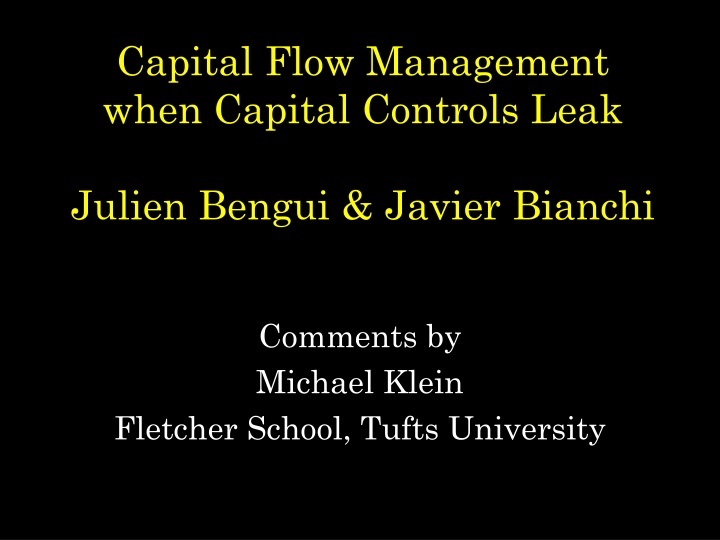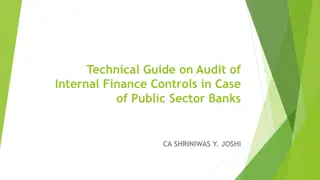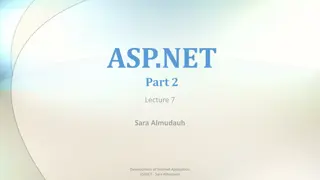Capital Flow Management Controls Leak: Insights & Policy Shifts
This content delves into capital flow management and the implications of capital controls leaking. It discusses various theories, empirical research, and policy implications surrounding the efficacy of capital controls, as well as macro stabilization and prudential theories. The content also highlights the work of researchers such as Bengui, Bianchi, Klein, Forbes, and others in refining policy theories and exploring the impacts of capital controls on different economic groups.
Download Presentation

Please find below an Image/Link to download the presentation.
The content on the website is provided AS IS for your information and personal use only. It may not be sold, licensed, or shared on other websites without obtaining consent from the author.If you encounter any issues during the download, it is possible that the publisher has removed the file from their server.
You are allowed to download the files provided on this website for personal or commercial use, subject to the condition that they are used lawfully. All files are the property of their respective owners.
The content on the website is provided AS IS for your information and personal use only. It may not be sold, licensed, or shared on other websites without obtaining consent from the author.
E N D
Presentation Transcript
Capital Flow Management when Capital Controls Leak Julien Bengui & Javier Bianchi Comments by Michael Klein Fletcher School, Tufts University
Capital Controls Redux* Keynes 1933: Above all, let finance be national Bretton Woods: Capital Controls 1980s, 1990s: Capital account liberalization Dornbusch 1998 Capital Controls: An Idea Whose Time Has Passed Early 2000s: More Eclectic view Mid-1stDecade: Increasing Use After Crisis Onset: IMF Reformation Regular tool? Jeanne, Subramanian & Williamson Blanchard et al. Other? Macroprudential Easier to implement, harder to circumvent than Capital Controls (Erdem Ba i) * Brought back, restored
This Conference: Research & Policy Policy shift prompts research Theory: Bianchi, Korinek, Mendoza, Jeanne, Werning & Farhi, Schmitt-Grohe & Uribe Empirics: Klein, Forbes, Fratzscher, Shambaugh Research refines policy Theory: Conceptual Empirics: Parameters, other factors Bengui & Bianchi: Empirics informs Theory. Efficacy of Capital Controls Gates vs. Walls
CFM: Towards What End? Macro Stabilization Theory: Farhi & Werning, Schmitt-Grohe & Uribe Empirics: Klein & Shambaugh Prudential Theory: Korinek, Bianchi, Mendoza Empirics: Klein, Forbes, Forbes & Warnock, Forbes & Klein, Forbes & Fratzscher
Bengui and Bianchi Sophisticated modelling, carefully done Transparent: Good job of developing intuition. Important Contribution 1st Generation: chosen optimally, effective resolves pecuniary externality of overborrowing But tension between theory & empirics: efficacy 2nd Generation: efficacy differs across groups. imposed only on Regulated, so must be bigger to address pecuniary externality also causes allocative inefficiency between Regulated and Unregulated groups. 2nd Generation vs. 1st Generation: Welfare gains from capital controls mitigated
Main Channel Collateral may constrain borrowing, b Two Groups: Restricted & Unrestricted bR,0 CR,0 WR,1 PN,1 WU,1 bU,0 Tax on inflows, 0, affects bR,0 bR,0 WR,1 pN,1 WU,1 bU,0 Mitigates aggregate effect of tax on inflows Where would inflows have gone? If pN is housing, could pN,1?
Efficacy and Character of Focus of paper Main result: Unregulated reduces efficacy Thus, must be bigger with increase (U/R) Optimal bigger w/ bigger initial wealth of the Unregulated? Who are Unregulated? Alfaro, Chari & Kanczuk: Differential effects across firms.
Efficacy and Character of Different assets rather than different agents? Short Maturity vs. Long Maturity Debt vs. Equity Some assets seen as more likely leading to a bust
Table 1: Capital Controls in Brazil, 2008-2012 2 asset classes Equity Event Date Debt Event Event 3/12/2008 IOF tax=1.5% on fixed income investments made by non-residents 10/22/2008 IOF tax=0% on fixed income investments following the collapse of Lehman Brothers IOF tax=2% introduced on equities and fixed income securities 10/19/2009 11/18/2009 Tax=1.5% on American Depositary Receipts (ADRs) converted into local stocks 10/4/2010 IOF tax=4% on fixed income bonds and derivatives 10/18/2010 IOF tax=6% on fixed income bonds and derivatives 3/28/2011 IOF tax=6% on overseas loans and bonds with maturities up to 1 year 4/6/2011 IOF tax to overseas bonds and bonds with maturities up to 2 years 7/26/2011 Tax of 1% on foreign exchange derivatives; legislation allow tax to be increased up to 25% 12/1/2011 IOF tax=0% on variable income instruments traded on the exchange and certain debentures 2/29/2012 IOF tax to cover overseas loans and bonds with maturities up to 3 years 3/9/2012 IOF tax to cover overseas loans and bonds with maturities up to 5 years 5/21/2012 IOF tax=1.5% for individual borrowers (from 2.5%) 6/13/2012 IOF tax to overseas loans and bonds with maturities up to 2 years 12/4/2012 IOF tax to overseas loans and bonds with maturities up to 1 year
Efficacy and Character of Dynamics: Multi-period, but when is imposed? Gates vs. Walls: Long-Standing or Episodic? Recognition / Implementation lags? more leaky over time? (like U/R w/time) Widening net as more leaky, not just increasing value of
Table 1: Capital Controls in Brazil, 2008-2012 Episodic Equity Event Date Debt Event Event 3/12/2008 IOF tax=1.5% on fixed income investments made by non-residents 10/22/2008 IOF tax=0% on fixed income investments following the collapse of Lehman Brothers IOF tax=2% introduced on equities and fixed income securities 10/19/2009 11/18/2009 Tax=1.5% on American Depositary Receipts (ADRs) converted into local stocks 10/4/2010 IOF tax=4% on fixed income bonds and derivatives 10/18/2010 IOF tax=6% on fixed income bonds and derivatives 3/28/2011 IOF tax=6% on overseas loans and bonds with maturities up to 1 year 4/6/2011 IOF tax to overseas bonds and bonds with maturities up to 2 years 7/26/2011 Tax of 1% on foreign exchange derivatives; legislation allow tax to be increased up to 25% 12/1/2011 IOF tax=0% on variable income instruments traded on the exchange and certain debentures 2/29/2012 IOF tax to cover overseas loans and bonds with maturities up to 3 years 3/9/2012 IOF tax to cover overseas loans and bonds with maturities up to 5 years 5/21/2012 IOF tax=1.5% for individual borrowers (from 2.5%) 6/13/2012 IOF tax to overseas loans and bonds with maturities up to 2 years 12/4/2012 IOF tax to overseas loans and bonds with maturities up to 1 year
Quantitative Implications: Rate Small optimal tax: 1% to 1.7%. Reasonable?
Table 1: Capital Controls in Brazil, 2008-2012 Size of Tax Equity Event Date Debt Event Event 3/12/2008 IOF tax=1.5% on fixed income investments made by non-residents 10/22/2008 IOF tax=0% on fixed income investments following the collapse of Lehman Brothers IOF tax=2% introduced on equities and fixed income securities 10/19/2009 11/18/2009 Tax=1.5% on American Depositary Receipts (ADRs) converted into local stocks 10/4/2010 IOF tax=4% on fixed income bonds and derivatives 10/18/2010 IOF tax=6% on fixed income bonds and derivatives 3/28/2011 IOF tax=6% on overseas loans and bonds with maturities up to 1 year 4/6/2011 IOF tax to overseas bonds and bonds with maturities up to 2 years 7/26/2011 Tax of 1% on foreign exchange derivatives; legislation allow tax to be increased up to 25% 12/1/2011 IOF tax=0% on variable income instruments traded on the exchange and certain debentures 2/29/2012 IOF tax to cover overseas loans and bonds with maturities up to 3 years 3/9/2012 IOF tax to cover overseas loans and bonds with maturities up to 5 years 5/21/2012 IOF tax=1.5% for individual borrowers (from 2.5%) 6/13/2012 IOF tax to overseas loans and bonds with maturities up to 2 years 12/4/2012 IOF tax to overseas loans and bonds with maturities up to 1 year
Quantitative Implications; Welfare Small optimal tax: 1% to 1.7%. Small welfare effects (as in Lucas). Utility?
Concluding Thoughts Important topic, bridging theoretical insights and empirical considerations. Elegant modeling, strong in building intuition so provides good insights. Can be extended in variety of ways: What would inflows have done? Also raised wealth through, say, real estate boom? Better targeted policies dominate capital controls? Gates or Walls? If Gates, when are policies imposed, does their efficacy erode over time? What do we learn from welfare comparisons?























